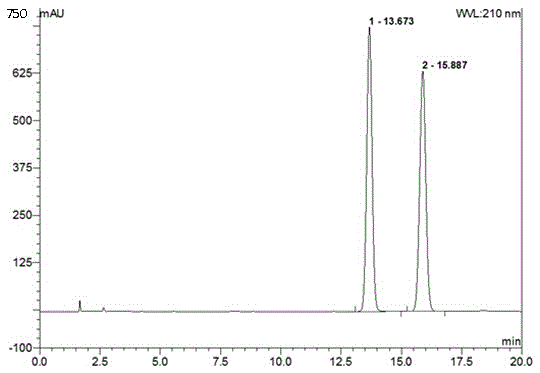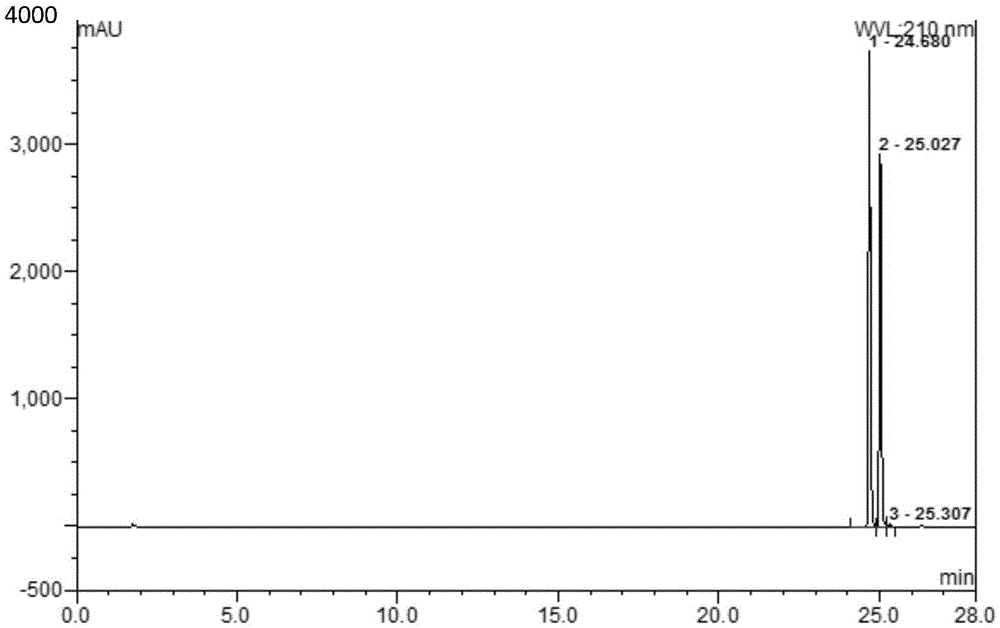Method for separating dapagliflozin and alpha-isomer thereof
A separation method and isomer technology, applied in the separation of dapagliflozin and its α-isomers, in the field of dapagliflozin, can solve the problems of chiral isomer impurities affecting the quality of drugs, etc., and achieve the analytical method Stable and reliable, high feasibility and strong practicability
- Summary
- Abstract
- Description
- Claims
- Application Information
AI Technical Summary
Problems solved by technology
Method used
Image
Examples
Embodiment 1
[0036] A method for separating dapagliflozin and its α-isomer, the steps are as follows:
[0037] Take 7.0mg of Dapagliflozin and its α-isomer respectively, put them in a 20mL volumetric flask, add acetonitrile-water to dissolve and dilute to the volume, shake well, and use it as the test solution; Chromatographic apparatus, PhenomenexLunaC (18) (250 × 4.6mm, 5μm) with octadecyl bonded silica gel as filler as chromatographic column, with a mixture of acetonitrile and water as mobile phase, using the following chromatographic separation conditions Separation:
[0038] The mobile phase flow rate is 1.0mL / min;
[0039] The temperature of the chromatographic column is 25°C;
[0040] The injection volume is 10 μL;
[0041] The detection wavelength is 210nm;
[0042] In the mobile phase, calculated by volume percentage, acetonitrile: water is 37%: 63%.
[0043] Chromatographic separation results see figure 1 shown, from figure 1 It can be seen from the figure that Dapaglifloz...
Embodiment 2
[0045] A method for separating dapagliflozin and its α-isomer, the steps are as follows:
[0046]Take 10.0mg of Dapagliflozin and its α-isomer respectively, put them in a 20mL volumetric flask, add acetonitrile-water to dissolve and dilute to the volume, shake well, and use it as the test solution; Chromatographic apparatus, PhenomenexLunaC (18) (250 × 4.6mm, 5μm) with octadecyl bonded silica gel as filler as chromatographic column, with a mixture of acetonitrile and water as mobile phase, using the following chromatographic separation conditions Separation:
[0047] The mobile phase flow rate is 1.0mL / min;
[0048] The temperature of the chromatographic column is 25°C;
[0049] The injection volume is 10 μL;
[0050] The detection wavelength is 210nm;
[0051] In the mobile phase, calculated by volume percentage, acetonitrile: water is 32%: 68%.
[0052] Chromatographic separation results see figure 2 shown, from figure 2 It can be seen from the figure that Dapaglifl...
Embodiment 3
[0054] A method for separating dapagliflozin and its α-isomer, the steps are as follows:
[0055] Take 10.0mg of Dapagliflozin and its α-isomer respectively, put them in a 20mL volumetric flask, add acetonitrile-water to dissolve and dilute to the volume, shake well, and use it as the test solution; Chromatographic apparatus, PhenomenexLunaC (18) (250 × 4.6mm, 5μm) with octadecyl bonded silica gel as filler as chromatographic column, with a mixture of acetonitrile and water as mobile phase, using the following chromatographic separation conditions Separation:
[0056] The mobile phase flow rate is 1.0mL / min;
[0057] The temperature of the chromatographic column is 25°C;
[0058] The injection volume is 10 μL;
[0059] The detection wavelength is 210nm;
[0060] In the mobile phase, calculated by volume percentage, acetonitrile: water is 42%: 58%.
[0061] Chromatographic separation results see image 3 shown, from image 3 It can be seen from the figure that Dapagliflo...
PUM
| Property | Measurement | Unit |
|---|---|---|
| Wavelength | aaaaa | aaaaa |
| Wavelength | aaaaa | aaaaa |
Abstract
Description
Claims
Application Information
 Login to View More
Login to View More - R&D
- Intellectual Property
- Life Sciences
- Materials
- Tech Scout
- Unparalleled Data Quality
- Higher Quality Content
- 60% Fewer Hallucinations
Browse by: Latest US Patents, China's latest patents, Technical Efficacy Thesaurus, Application Domain, Technology Topic, Popular Technical Reports.
© 2025 PatSnap. All rights reserved.Legal|Privacy policy|Modern Slavery Act Transparency Statement|Sitemap|About US| Contact US: help@patsnap.com



